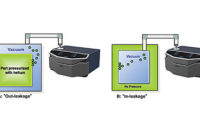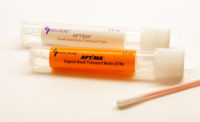On the surface, leak testing may appear to be a straightforward process. In reality, finding a leak testing system that is ideally suited to your application can be deceivingly complex. So before engineers contact potential suppliers, they need to do a little homework.
Today’s automatic leak testing equipment can test assemblies without operator attention or interpretation. It can:
- Test more than one part model.
- Perform both leak and flow tests on two or more parts sequentially or simultaneously.
- Apply both positive and negative pressure.
Automatic leak testers can typically test a part in 0.9 to 30 seconds. After a complete test cycle, the equipment displays the quantitative results of the test, as well as the accept or reject status of the assembly. The operator sets accept or reject limits.
Today’s testers can communicate with programmable logic controllers, store test data, monitor testing trends, change test programs automatically, compensate for temperature variations, and issue an alarm in case of calibration tampering. Many units also have maintenance programs.
There are many ways to test an assembly for leaks: pressure decay, vacuum decay, differential pressure decay, mass flow, differential pressure flow, pressure increase, and chamber testing. Pressure decay and vacuum decay testing are the most popular because of their ruggedness and simplicity.
When buying a leak testing system, engineers should choose a supplier with experience in multiple leak testing methods. The supplier should also be experienced in designing test tooling, which is important to the success of a leak testing project. Finally, look for quality registrations, such as ISO 9001, the Canadian Standards Association and the European CE mark. These registrations ensure that you will receive a quality system with good documentation and solid software.
Providing Specifications
When specifying a leak testing system, engineers should thoroughly describe the product to be tested, including all the materials in the assembly and the part numbers. They should also provide the following information: test volume, production rate, test pressure, and the minimum leak rate for a reject. If the test parameters are not available, explain the test application or any problems to the supplier.
For a new product, a number of variables should be considered when setting the leak test specifications. Answers to the following questions will be helpful:
- How is the product used?
- Is the goal to prevent leakage of liquid or air?
- What type of liquid or gas is used in the product?
- What materials are used in the product?
- What is the working pressure of the product?
- What are the consequences of a leaking product?
The last question is particularly important, because it helps determine how accurate the test needs to be. Will a leak result in a life-threatening situation? Will a leak cause the product to malfunction, or will it only result in inconvenience or an unsightly appearance?
Speed and resolution are major considerations when purchasing a leak tester, but they should also be viewed with caution. For example, a supplier may claim that its equipment has a resolution of 0.0001 psi. Be aware that this usually refers to just one component of the system—the analog-to-digital converter. While the claim may be true, it is simply not a useful figure. To determine the actual resolution, the entire system must be considered—electronics, sensors and components. Only then will you get a true picture of the system’s actual resolution.
Similarly, engineers should be skeptical of claims that a unit can detect leaks as small as 0.01 cc per minute. The unit may, indeed, be able to detect leaks that small, but it may only be achievable in a few applications. As with resolution, the true testing sensitivity depends on the total system, including the part and test specifications.
Purchasing a leak tester based on exaggerated claims of resolution and speed can be a costly mistake. Be suspicious of claims that a leak tester is unaffected by temperature or test volume or that it can predict leaks before a complete test cycle is finished. These claims may sound appealing, but, as the saying goes, if it sounds too good to be true, it usually is.
A leak tester may be able to “predict” leaks before a complete test cycle is finished—but it’s only true for large leaks and almost any leak tester can do this. Regardless of the test technology, only a complete cycle will ensure a repeatable and reliable leak test. Anything less will cause false rejects or allow leaking parts to pass. Similarly, all air leak testers require a pressure differential across the leak. The differential pressure causes pressure decay or flow. Both are affected by temperature and test volume size. The laws of physics have not changed.
Another issue to consider when buying a leak tester is flexibility. Initially, many engineers want a leak tester that simply reports “go” or “no go” results. Later, however, they realize the importance of quantifying the results. As specifications change, new products are designed, and existing products are adapted, different types of leak testing will be required. When that happens, the need for data collection, statistical analysis, bar code reading, temperature compensation, and connection with local area networks often becomes apparent.
Although flexibility may increase the initial cost of the tester, it can save time and money over the lifetime of the system.
Never buy a leak tester based solely on price. You may save several thousand dollars, but this seemingly large savings up front can actually cost big money later in inadequate technical support, poor performance, breakdowns, poor software maintenance and documentation, calibration failures and training costs. Always consider the long-term value that will be received through years of ownership and a partnership with a successful and innovative supplier.




